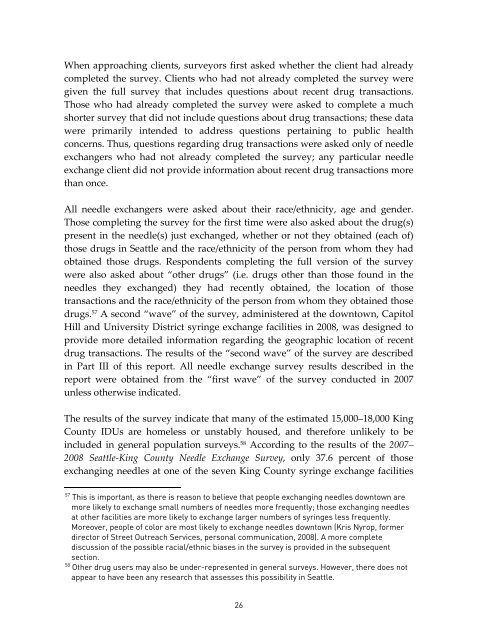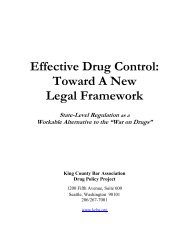RACE AND THE ENFORCEMENT OF DRUG DELIVERY LAWS IN ...
RACE AND THE ENFORCEMENT OF DRUG DELIVERY LAWS IN ...
RACE AND THE ENFORCEMENT OF DRUG DELIVERY LAWS IN ...
Create successful ePaper yourself
Turn your PDF publications into a flip-book with our unique Google optimized e-Paper software.
When approaching clients, surveyors first asked whether the client had already<br />
completed the survey. Clients who had not already completed the survey were<br />
given the full survey that includes questions about recent drug transactions.<br />
Those who had already completed the survey were asked to complete a much<br />
shorter survey that did not include questions about drug transactions; these data<br />
were primarily intended to address questions pertaining to public health<br />
concerns. Thus, questions regarding drug transactions were asked only of needle<br />
exchangers who had not already completed the survey; any particular needle<br />
exchange client did not provide information about recent drug transactions more<br />
than once.<br />
All needle exchangers were asked about their race/ethnicity, age and gender.<br />
Those completing the survey for the first time were also asked about the drug(s)<br />
present in the needle(s) just exchanged, whether or not they obtained (each of)<br />
those drugs in Seattle and the race/ethnicity of the person from whom they had<br />
obtained those drugs. Respondents completing the full version of the survey<br />
were also asked about “other drugs” (i.e. drugs other than those found in the<br />
needles they exchanged) they had recently obtained, the location of those<br />
transactions and the race/ethnicity of the person from whom they obtained those<br />
drugs. 57 A second “wave” of the survey, administered at the downtown, Capitol<br />
Hill and University District syringe exchange facilities in 2008, was designed to<br />
provide more detailed information regarding the geographic location of recent<br />
drug transactions. The results of the “second wave” of the survey are described<br />
in Part III of this report. All needle exchange survey results described in the<br />
report were obtained from the “first wave” of the survey conducted in 2007<br />
unless otherwise indicated.<br />
The results of the survey indicate that many of the estimated 15,000–18,000 King<br />
County IDUs are homeless or unstably housed, and therefore unlikely to be<br />
included in general population surveys. 58 According to the results of the 2007–<br />
2008 Seattle-King County Needle Exchange Survey, only 37.6 percent of those<br />
exchanging needles at one of the seven King County syringe exchange facilities<br />
57<br />
This is important, as there is reason to believe that people exchanging needles downtown are<br />
more likely to exchange small numbers of needles more frequently; those exchanging needles<br />
at other facilities are more likely to exchange larger numbers of syringes less frequently.<br />
Moreover, people of color are most likely to exchange needles downtown (Kris Nyrop, former<br />
director of Street Outreach Services, personal communication, 2008). A more complete<br />
discussion of the possible racial/ethnic biases in the survey is provided in the subsequent<br />
section.<br />
58 Other drug users may also be under-represented in general surveys. However, there does not<br />
appear to have been any research that assesses this possibility in Seattle.<br />
26

















